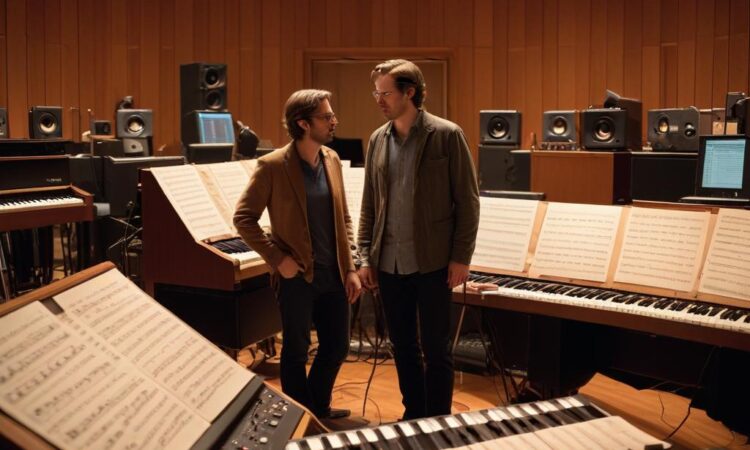The Role of Music in Film: An Unseen Symphony
The power of music to evoke emotions, transport us to other worlds, and enhance storytelling is undeniable. In film, music transcends its role as mere background noise; it becomes an integral part of the narrative, weaving itself seamlessly into the fabric of the cinematic experience. From the iconic soundtracks that define entire genres to the subtle background scores that guide our emotional responses, music plays a crucial role in amplifying the impact of film on our hearts and minds.
The Symphony of Emotion: How Music Enhances Film
Music possesses an uncanny ability to tap into our deepest emotions, often more effectively than dialogue or visuals alone. A poignant melody can amplify the sorrow of a heartbreaking scene, while a rousing score can elevate a thrilling action sequence to new heights of intensity. This power of music to evoke emotions is central to its role in film.
Consider the iconic opening theme of \”Jaws,\” composed by John Williams. The two-note motif, played by a low, ominous cello, instantly evokes a sense of dread and anticipation, setting the stage for the terrifying encounter with the great white shark. This is just one example of how music can define a film’s emotional landscape, shaping the audience’s perception of characters, events, and themes.
Music can also be used to create a sense of place and time. The soundtrack of \”The Godfather\” by Nino Rota, with its haunting melodies and use of traditional Italian instruments, transports us to the world of organized crime in 1940s New York. Similarly, the driving rhythms and electronic sounds of a film set in a dystopian future can effectively establish a sense of alienation and uncertainty.
Furthermore, music can serve as a powerful narrative tool. It can foreshadow events, build suspense, and even provide a voice for characters who cannot speak for themselves. For example, in \”Titanic,\” the haunting melody of Celine Dion’s \”My Heart Will Go On\” echoes the tragic romance of Rose and Jack, adding an extra layer of emotional depth to the film.
The Collaborative Art: Composer and Filmmaker
The magic of music in film is a result of the intricate collaboration between composer and filmmaker. This partnership goes beyond simply adding a soundtrack to a completed film; it involves a deep understanding of the film’s narrative, characters, and themes. The composer must be able to translate the filmmaker’s vision into music, creating a score that complements and enhances the visual storytelling.
This collaboration often begins in the early stages of pre-production, with the composer working closely with the director and screenwriter to understand the film’s essence. The composer may attend script readings, view storyboards, and even visit locations to immerse themselves in the film’s world. This immersive process ensures that the music created will be organically integrated into the film.
During production, the composer may attend filming sessions, providing cues for actors and working with the sound designer to ensure that the music blends seamlessly with the dialogue and sound effects. This collaborative approach allows the composer to understand the film’s nuances and rhythms, creating a score that is both technically precise and emotionally resonant.
The Evolution of Music in Film: A Shifting Landscape
The role of music in film has evolved significantly over time. From the silent era, where music was used primarily to provide a soundtrack for the action on screen, to the advent of sound and the rise of iconic film scores, the relationship between music and film has become increasingly complex and nuanced.
In the silent era, musicians often performed live in the cinema, accompanying the film with improvised scores based on the action and emotions on screen. This created a more intimate and fluid cinematic experience, where the music could respond dynamically to the film’s unfolding narrative.
With the introduction of sound, music became an integral part of the film’s production process. Composers began to create scores that were specifically tailored to the film’s story and characters, weaving music into the fabric of the cinematic experience. The rise of iconic scores, such as those by John Williams, Ennio Morricone, and Bernard Herrmann, cemented the importance of music in defining the film’s mood, themes, and emotional impact.
In recent years, the use of music in film has become even more sophisticated. Composers are experimenting with new genres, blending electronic music with orchestral arrangements, and incorporating soundscapes that evoke specific moods and atmospheres. This trend reflects the evolution of music itself, as well as the changing tastes and expectations of audiences.
The Unseen Symphony: Music as a Key to Film’s Power
Music in film is often an unseen but powerful force, shaping our emotional responses, guiding our understanding of the narrative, and enhancing our overall cinematic experience. From the iconic soundtracks that define entire genres to the subtle background scores that weave their way into the fabric of the film, music is an essential element of the cinematic art.
The collaboration between composer and filmmaker is a testament to the power of creative synergy, where music transcends its role as mere entertainment and becomes an integral part of the storytelling process. As we continue to explore the world of film, we can appreciate the remarkable role that music plays in shaping our emotional connection to the stories we see unfold on the screen.

